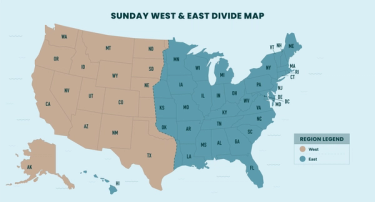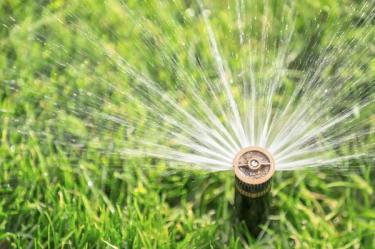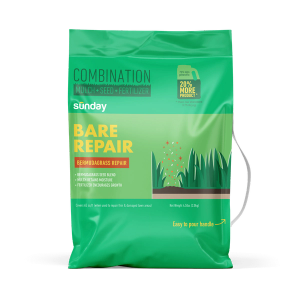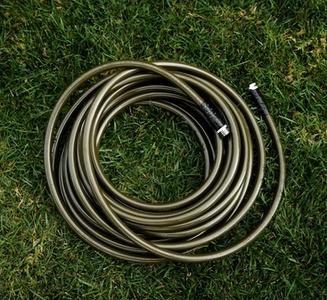Perfect lawn watering isn't just about turning on the sprinkler—it's about knowing when, how much, and how often to water. Let's make sure your grass gets exactly what it needs.
Note: This guide is for healthy, established lawns. New lawns or lawns experiencing disease check out our special watering guides!
The basics of lawn watering
The key to success? Water deep and infrequently. This Sunday watering strategy helps develop strong, deep roots for a healthier lawn.
How much to water your lawn
- Aim for 1/3 to 1/2 inch per session
- Usually, watering a lawn takes about 30 minutes
- Adjust based on your specific lawn areas:
- Sunny spots may need more
- Shady areas often need less
Sunday Tip:
Use the tuna can trick! Place empty tuna cans around your lawn while watering. When they have 1/3 to 1/2 inch of water, you've watered enough.
Best time to water your lawn
Morning is best (6 a.m. - 10 a.m.).
- Maximizes water absorption
- Prevents disease
- Reduces heat stress
- Minimizes evaporation
If you are dealing with water restrictions or located in a water conservation area, you can water between 10 p.m. and 6 a.m. to conserve water and abide by municipality restrictions.
How often to water your lawn
The magic number is 1-3 times per week, but this varies by region, current season, recent rainfall, and local climate.
Give your soil time to dry between sessions, and skip watering if it rains. The goal is to create a cycle that mimics natural rainfall patterns.
Most importantly, avoid daily watering—it leads to:
- Shallow, weak roots
- Increased disease risk
- More weed problems
- Patchy grass growth
Regional watering guide
Lawn watering practices greatly depend on where you are in the continental US—mainly, how much natural rainfall your lawn receives.

How to water in Eastern US
Northeast and North Central: Natural rainfall usually suffices here, but you'll need to supplement during summer dry spells. Watch for signs of drought stress during hot periods.
Southeast: With high humidity and regular rainfall, your lawn's watering needs are often met naturally. Only add irrigation if you've gone more than a week without rain.
How to water in Western US
The arid climate here means regular irrigation is crucial. Stay vigilant about:
- Monitoring for signs of drought stress
- Following local water restrictions
- Considering drought-resistant grass varieties
Sunday Tip:
Your region's rainfall patterns should guide your watering schedule. Check our regional lawn guides for specific recommendations.
How to know if you're watering right: quick check
Your lawn will tell you if you need to adjust your watering. Here's what to watch for:
- Footprints staying visible? → Increase watering
- Lawn feels squishy? → Decrease watering
- Grass springs back after walking? → Perfect amount
- Brown patches? → Check water distribution
- Standing water? → Improve drainage
Common watering questions
Am I watering my lawn enough?
The best way to check is surprisingly simple: grab a small trowel and dig down about 6 inches after watering. This is your grass's root zone, and it should feel consistently moist, not sopping wet or bone dry. If the soil at this depth is dry, you need to water longer to help those roots grow deep and strong.
Does my soil type matter?
Your soil type plays a big role in how you should water.
Sandy soil drains quickly, so you might need to water more often but for shorter periods.
Clay soil, on the other hand, needs a different approach. Try cycle soaking: water for 10 minutes, let it soak in for 10 minutes, then repeat until enough water reaches the roots.
How can I measure my lawn's water intake?
Here's a simple DIY trick: place a few flat, shallow containers (tuna cans work great!) around your lawn. Run your sprinklers for about 30 minutes, then measure the water depth with a ruler. You're aiming for 1/3 to 1/2 inch of water. If you're getting more than that, you can reduce your watering time.
Fine-tuning your watering routine
Remember that these guidelines are just starting points. Every lawn is unique, and yours will show you what it needs. Watch how your grass responds and adjust your irrigation routine seasonally. With some practice and observation, you'll become a grass whisperer in no time.
Ready to create a custom watering schedule for your specific lawn? Let us help you build the perfect plan.

Cited sources
Water-saving strategies for home lawns. University of Minnesota Extension.
Water Wise Lawns. Cornell University Extension
Watering Established Lawns. Colorado State University Extension.


















